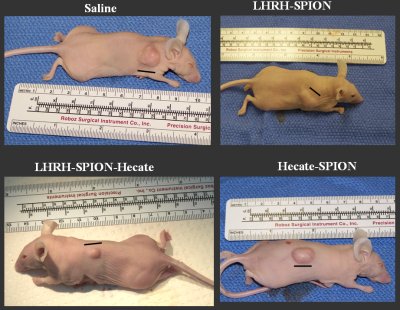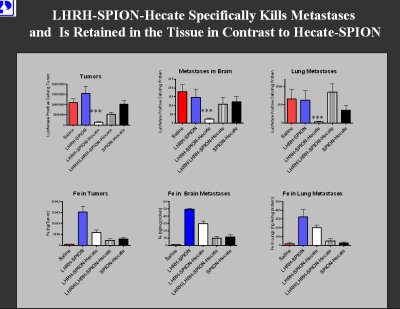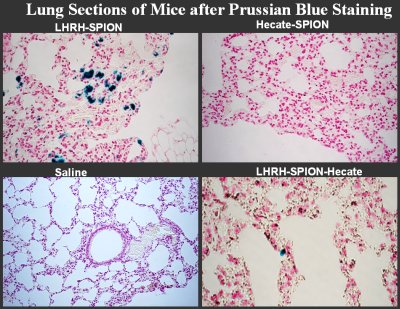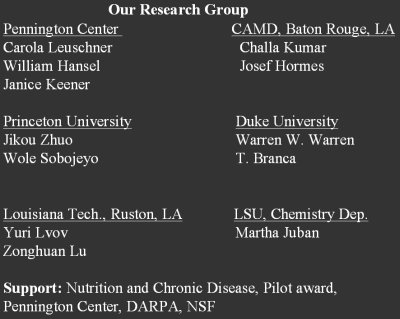Imaging and Treatment of Cancer through Combinations of Nanoparticles and Hormones
Carola Leuschner, Ph.D.
Page 4 of 4
In an in vivo experiment using the above introduced cancer xenograft mouse model we intend to test if we can destroy cancer cells, in particular metastatic disease with this
approach. We have a saline control group and groups of xenografted mice for the different treatment groups. These mice are bearing breast cancer xenograft, a very large tumor.

Image 10
In the groups injected with LHRH SPIONs, just the contrast agent, the large tumor is retained. There is no cell death of tumor cells observed. However, if we have injected conjugated the SPIONs with LHRH in combination with a drug, we have a reduction of the primary tumor.
The important point is that if we leave out the targeting moiety, we cannot destroy the tumor cells. It is a very important that the tumor cells are accumulating the SPIONs bound together with the drug. They can only do this by being targeted with the ligand, which is specifically binding on the tumor cells. Without that we have no binding and no tumor cell reduction.
This is a summary image of what happened and how many metastases and live tumor cells we have after the treatment. The saline controls are in red. We have a fairly high number of tumor cells. We have a fairly high number of metastases from the primary tumor, and a fairly high number of lung metastases.

Image 11 [Click above for larger image]
If we treat with a LHRH-SPION-Hecate construct, we drastically reduce the primary tumor, we reduce brain metastases, and also lung metastases. We can specifically destroy these cells with that construct.
We also have (depending on the injection), an increased accumulation of iron. This is the iron accumulation in the tumors. We have increased iron accumulation in the brain, and also in the lungs, all of which have been treated with LHRH-SPION-Hecate.
If we just look at SPION-Hecate, the untargeted compound, we have very little, accumulation on primary tumors, no destruction of brain metastases, no destruction of lung metastases, and very little accumulation of iron in tumors, brain metastases, or lung metastases suggesting that this is a very specific compound we are testing here.

Image 12
This section shows lung sections which have been excised out of treated mice with LHRH-SPION-Hecate. This is iron, what you see here, iron particles directly accumulating in the lungs. LHRH-SPION injected animals really have not accumulated iron in the metastases of the lung, which we cannot even see in Hecate-SPION injected mice. No labeling because of no accumulation of SPIONs in the lungs.
To summarize our results, we specifically are able to target and  destroy breast cancer
xenograft, and the metastases from lymph nodes, bones, brain, and lung. Unconjugated construct of SPION with the drug is not effective in destroying tumor and metastases.
destroy breast cancer
xenograft, and the metastases from lymph nodes, bones, brain, and lung. Unconjugated construct of SPION with the drug is not effective in destroying tumor and metastases.
The nanoparticles are retained in treated tissue even after destruction of metastases, which would open up a new avenue to simultaneously monitor and treat at the same time, so that would certainly have future impact on our imaging and treatment modalities.
We have a very specific mechanism of action, it is a concept that is dependent on expression of surface receptors on the target cells. We do not see any side effects like changing body weight. Liver and other weights are unaffected by treatment, so are the hematological parameters.
Liver and kidney functions are absolutely unchanged in treated animals. Platelets, erythrocytes, leukocytes [1] are normal in treated or untreated animals, so we really do not see any side effects and it's a very safe approach.
In conclusion, this treatment approach may have promising application for simultaneous treatment imaging, and may be useful for directly monitoring treatment response non invasively in cancer patients.

Image 13: Research Group
I would like to thank our research group from the Pennington Biomedical Research Center, the Center for Advanced Microstructure and Devices; Doctor Kumar, Josef Hormes. Doctor Warren and Doctor Branca from Duke University and Louisiana Tech’s, Doctor Lvov and his new chemistry department.
Footnotes
1. Platelets – n. a minute, irregularly shaped, disk-like cytoplasmic body found in blood plasma that promotes blood clotting and has no definite nucleus, no DNA, and no hemoglobin. Also called blood platelet, thrombocyte.
The American Heritage STEDMAN’S Medical Dictionary. Boston, New York: Houghton Mifflin Company, 2004: 640.
Erythrocyte – n. see red blood cells. Red blood cell – n. Abbr. RBC, rbc. A disk-shaped, biconcave cell in the blood that contains hemoglobin, lacks a nucleus, and transports oxygen and carbon dioxide to and from the tissues. Also called erythrocyte, red cell, and corpuscle.
The American Heritage STEDMAN’S Medical Dictionary. Boston, New York: Houghton Mifflin Company, 2004: 276, 700.
Leukocyte – or leucocyte – n. See white blood cell. White blood cell – n. Abbr. WBC Any of the colorless or white cells in the blood that have nucleus and cytoplasm and help protect the body from infection and disease through specialized neutrophils, lymphocytes, and monocytes. Also called leukocyte, white corpuscle.
The American Heritage STEDMAN’S Medical Dictionary. Boston, New York: Houghton Mifflin Company, 2004: 458, 886.
Bio
 Prof. Carola Leuschner, Ph.D.,
Prof. Carola Leuschner, Ph.D.,
Pennington Biomedical Research Center
Louisiana State University
Baton Rouge, Louisiana
Dr Leuschner received her Ph.D. in Biochemistry from the University of Hannover, Germany in 1993.
Dr. Leuschner's areas of interest are development of new methods for treating prostate, breast, testes, and ovarian cancers based on targeting lytic peptides to specific receptors on the cancer cell membranes. In addition, the detection and treatment of spreading tumor cells, which later can lead to metastases, are her main areas of interest. She is also very much interested in collaborating with colleagues of the nutrition and cancer groups to study whether nutrition and lytic peptide conjugate treatments can benefit the patients.
"The take home message is that you need to have a targeted entity to kill the cancer cells," Dr. Leuschner says. "Without [an] LHRH targeting moiety, the nanoparticle-drug construct doesn't kill the cancer cells and it's like a generally systemic chemotherapy drug."